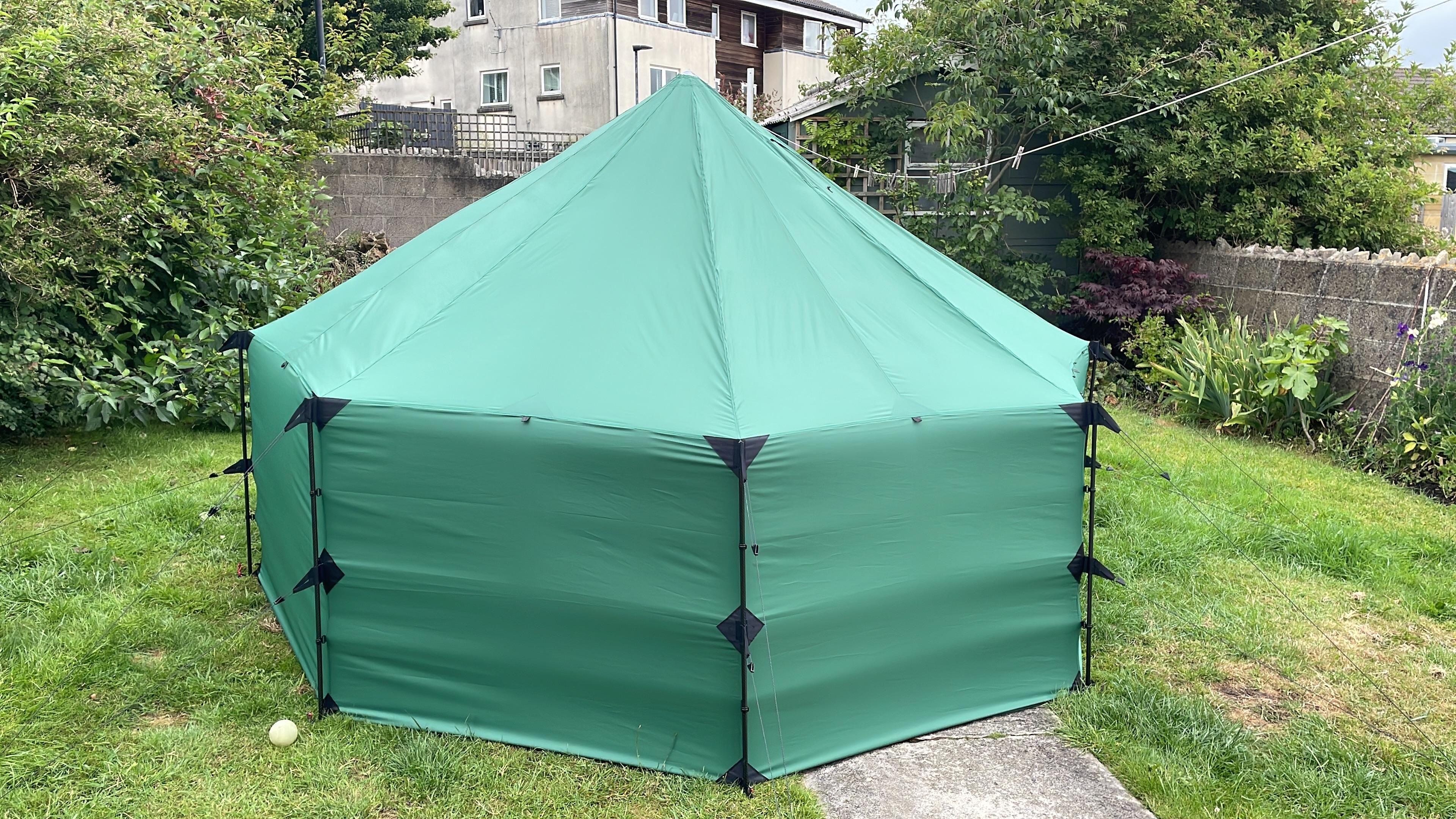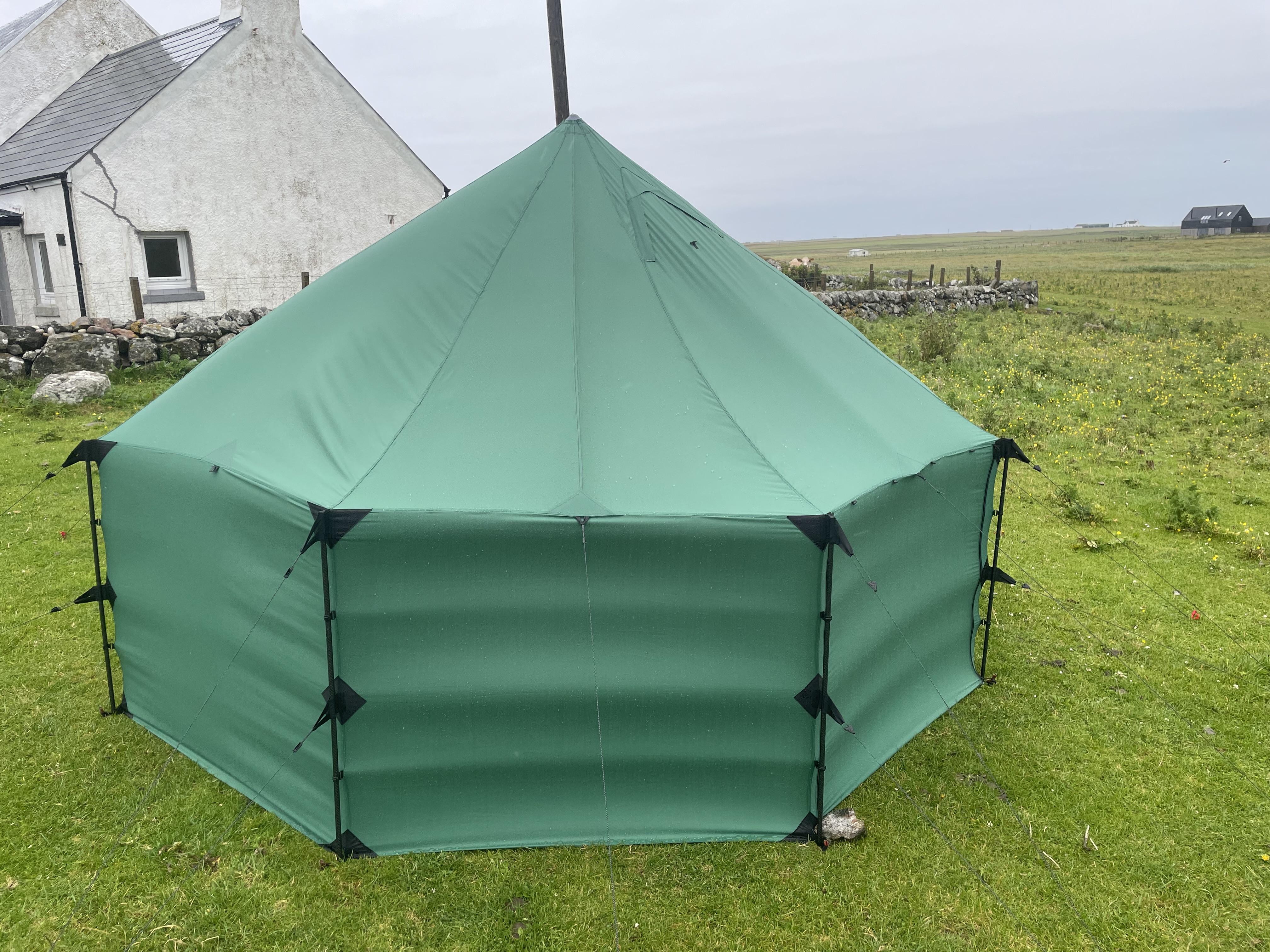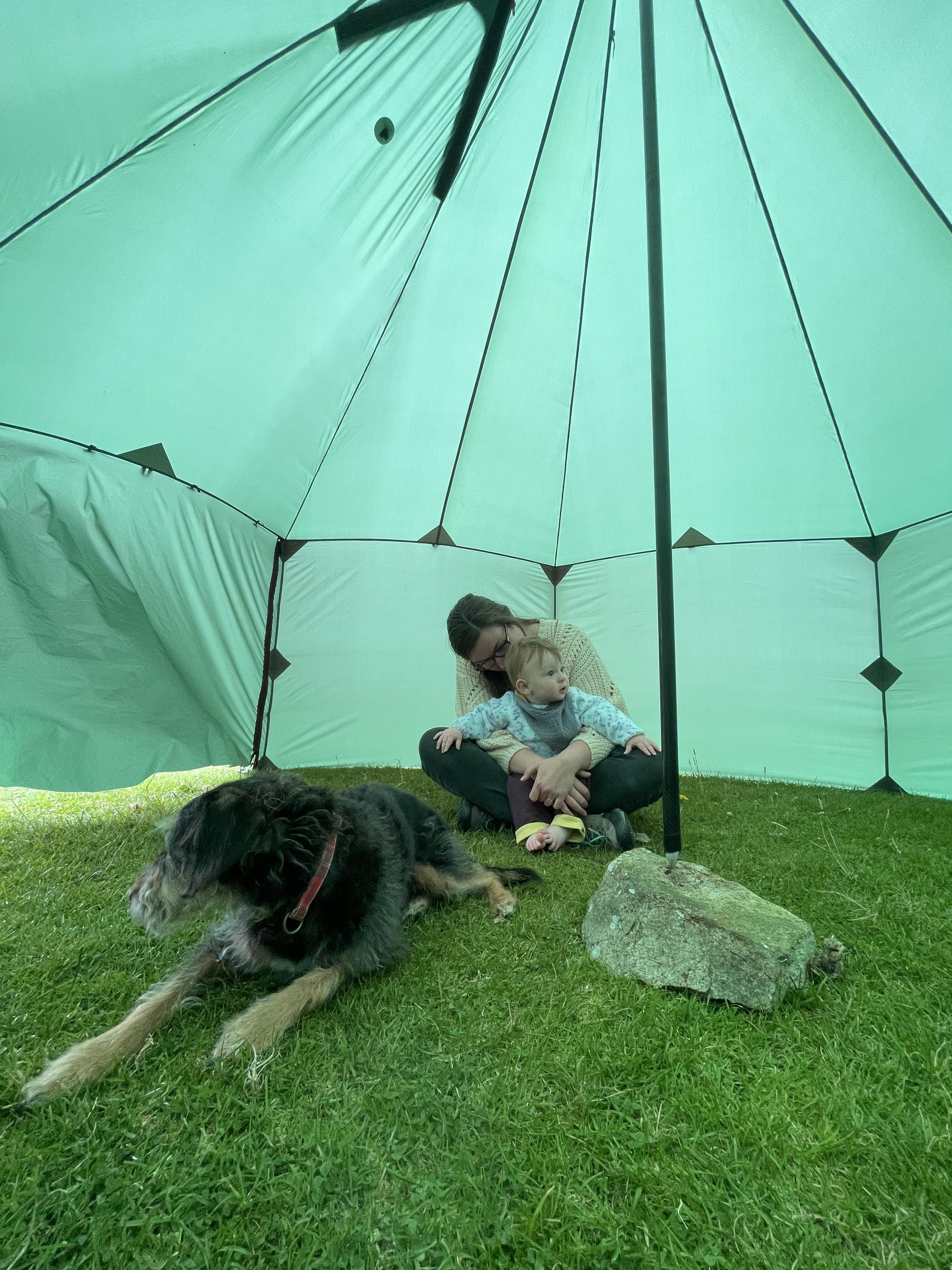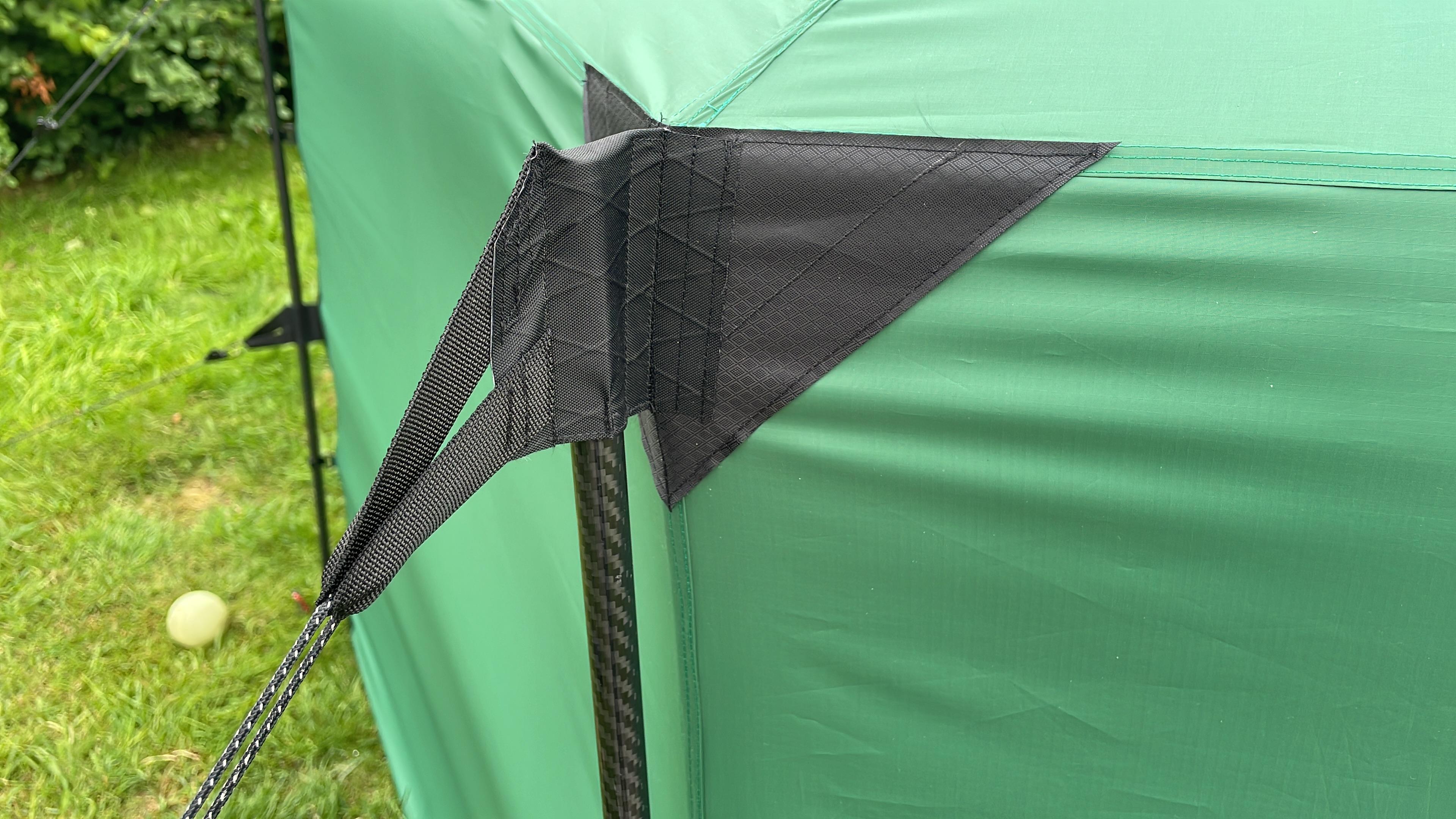Topic
I made a massive group tent but I might need to redesign….help!
Forum Posting
A Membership is required to post in the forums. Login or become a member to post in the member forums!
Home › Forums › Gear Forums › Make Your Own Gear › I made a massive group tent but I might need to redesign….help!
- This topic has 6 replies, 5 voices, and was last updated 5 months, 1 week ago by
 Henry Shires / Tarptent.
Henry Shires / Tarptent.
-
AuthorPosts
-
Aug 12, 2024 at 2:29 am #3816311
Hi All,
I managed to complete my heaxagonal group tent mentioned in a previous post just over a month ago. Its 3m wide, 2m high and has 1m vertical sides. It is a fly only tent designed to comfortably sit a group in rainy weather on my group backpacking trips (mostly in the Drakensberg, where it will also double as sun protection.
All the poles are carbon fibre. Its made from 1.6oz silpoly from RSBTR. The reinforcements are various go from 1.6 silpoly all the way to excessively strong pack materials for the pole sleeves. I used ‘sew-all’ polyester thread which seems plenty strong enough to be honest. The seams are all faux-felled and also seem plenty strong enough. I’ve piched it in a 25mph wind and it coped fine. The seam sealing works well and its watertight. It weights 3.2kg including everything.



 However there are some fairly major issues! To pitch it in 25mph winds required a LOT of tension. It means extending the centrepole far far more than the 2m I had designed. its more like 2.3m at a guess. I also have to put ridiculous tension on the guylines. This seems to be because I have not done any caternary cuts and all the seams are on the bias. This leaves an enormous amount of stretch in the seam (I would guess at 15cm or so on a 2m length) and this pulls the tent out of shape. But even with masses of tension, these seam still stretch too much, so wind causes the roof area to billow and deform, greatly limiting its usefulness in inclement weather. This seems a big shape because in other areas I think the tent is excessively strong. The carbon fibre poles are far stronger than they need to be (14mm outer poles, 25mm inner pole, the latter of which I had left over from a previous unrelated project).
However there are some fairly major issues! To pitch it in 25mph winds required a LOT of tension. It means extending the centrepole far far more than the 2m I had designed. its more like 2.3m at a guess. I also have to put ridiculous tension on the guylines. This seems to be because I have not done any caternary cuts and all the seams are on the bias. This leaves an enormous amount of stretch in the seam (I would guess at 15cm or so on a 2m length) and this pulls the tent out of shape. But even with masses of tension, these seam still stretch too much, so wind causes the roof area to billow and deform, greatly limiting its usefulness in inclement weather. This seems a big shape because in other areas I think the tent is excessively strong. The carbon fibre poles are far stronger than they need to be (14mm outer poles, 25mm inner pole, the latter of which I had left over from a previous unrelated project).I think I have ultimately made the tent a bit too big. I would like it to comfortably sit 8, but in reality I think you could sit 16 at a squeeze ( per side). I also think I have made it too tall, the pyramid portion just catches the wind too much, and since the tent will mostly be sat in, this seems like a bit of an error. So I am likely to redesign to reduce the height to more like 1.7m (but design for 1.6 because of the stretch!) and bring the sides in by 20cm or so.
So to the questions:
How should I redesign the roof? I have various ideas….
1. Change materials to something stronger with less bias stretch (but I dont know what this would be and RSBTR do not have data, only telling me that 1.6 silpoly is actually already pretty good in this regard)2. Keep the same cutting orientation with the main seams on the bias and the centre of the panel being with the grain, but add caternary cuts to improve tension and perhaps shorten the length of the seam slightly?
3. Cut 16 triangles so that I can pair them up in such a way that all main seams are with the grain, but that the seam that joins each pair is on the bias (perhaps with a cat cut as well?)
4. Cut 16 panels but make it so that every seam is a combination of with the grain and slightly bias cut.
These are my ideas so far. I think reducing the size of the tent slightly will make a world of difference on its own, but I would like to do as much as possible to make a really strong tent that is less susceptible to the wind, because those ‘walls’ are really really strong!
Thanks for your help,
Alex
Aug 12, 2024 at 8:56 am #3816314wow, well done!
Are the reinforcing black triangles a heavier, stiffer fabric? It would be better if they were the same fabric as the tent, then both layers (tent and reinforcement) would stretch and share the load. A little less likely that the seam between them would tear. But that’s more theoretical, unlikely for yours to tear.
ridges stretching on the bias seems to be the biggest problem with pyramid tents, in my experience. Bias stretch depends on the weave of the fabric, which can vary more than the stretch of the actual fibers, I think.
If you do more catenary cut, then it makes the peak steeper so there’s less effective headroom inside. Which is fine, you just have to make the peak a little taller. Your tent is tall so it doesn’t matter.
I’ve had the same experience – tent ended up taller than I expected because of bias stretch.
I’ve added catenary curve to a tent that’s completed. Take the line that is the first line of stitches of the faux flat felled seam. Make a mark every 2 inches. Use one of those spreadsheets to calculate the deflection at each 2 inch mark. Make a mark for each deflection point. Then, sew a line of stitches through those points. Then fold over the loose fabric twice and sew through that like a faux flat felled seam. At both ends, the deflection goes to zero, so you can’t fold over twice all the way to the end. So, if you err by not putting enough cat curve you can fix that.
For the ridges, to get around the bias stretch problem, I sew on a piece of 1/2 inch polyester grosgrain. $8 from amazon for 25 yards. I have zero trust that that would actually be polyester, but you can verify that by taking a 6 foot length. Carefully mark the 6 feet with the slack taken out but no stretch. Then put 20 pounds of force on it and measure it again – if it’s polyester it will stretch 1 inch. If it’s nylon it will stretch several inches. Too bad rsbtr or whoever doesn’t carry this.
Then sew the grosgrain to the ridge. Sew back and forth a few times the end of the grosgrain to the peak reinforcement. Then sew down one row of stitches the grosgrain to the ridge. Make sure you don’t stretch either the grosgrain or the fabric – you want them to match when the slack is taken out but not stretched. Then, when you set up the tent, the grosgrain will stretch about an inch which will make the tent fabric stretch (along the bias) enough but not too much.
At the edge of the tent, cut the grosgrain about one inch too long, then fold it over and sew it to make a loop for the guyline to go through. Then, the force from the guyline will be directed to the ridge.
When you design your tent, you can lay out the fabric one inch shorter than the design so as pitched, it will actually be the height you want to match your center pole
I like the background in your pictures. It must be windy there. It looks like your tent is blowing around a little.
Aug 12, 2024 at 10:44 pm #3816360Very cool tent, Alex.
Yurts once dominated half the world. I expect yours to do similarly well, now that you can make them out of modern materials. :)
Aug 14, 2024 at 2:28 am #3816403Thanks Bill. To be honest, because I take my groups to very exposed locations I am quite obsessed with wind resistance and I dont think this quite does what I want!
Thanks for such a thorough reply Jerry.
The reinforcings are of a heavier fabric but the combination really is excessively strong, far far stronger than any pegging could be I think! So at least that part is OK, but thats an interesting point about using the same materials.
Yes it does seem that the bias stretch is far more dependent on the weave than anything else. To be honest there is very little difference in my opinion between this 1.6oz silpoly and the HyperD 300 that I used for the reinforcings. It leads me to believe that the solution is probably not in a material change unless I went to cuben etc which is totally out of the question due to immense cost!
I like the idea of doing cat cuts after the fact and you have explained that well. There is no doubt that the lack of cat cuts is ultimately responsible for an excess of fabric being pulled around the roof of the tent to create a hollow for the wind, as you can see in the picture. Unfortunately, my desire to make something pretty and perhaps not waste unnecessary time on something I might have to start over with might win the day! I think this would definitely help, but perhaps not quite enough.
Your solution to add grossgrain to the ridges is very clever, particularly when incorporating that into a guyline attachment. I would never have thought of that. Even the nylon grosgrain I have stretches so little relative to the bias stretch that I’m inclined to try using just that. But again, this makes me want to incorporate the ribbon into the faux felled seam for neatness on the inside, or perhaps just attaching it with the final ‘third’ line of stitching. The more I think about this the more I like the idea, because the silpoly is otherwise completely suitable for the task.
Thanks so much for taking all that time, it really is very generous of you!
Alex
Aug 14, 2024 at 8:30 am #3816407That’s not my idea to use reinforcements of the same material. It’s really more theoretical. I don’t think that’s a common failure. I like the contrasting color in your tent.
adding a cat curve after the fact is just something I stumbled upon. Better than having to make a whole new tent. When I was done, it looked normal.
I try to minimize the number of prototypes. Learn everything I can from the first prototype before doing the second. By adding a cat curve, I can then determine if that actually works. The next prototype can have that cat curve from the start.
My current tent has many kludges frankensteined onto the tent. One of these days I’m going to make a new tent with all the changes that work incorporated.
I haven’t heard the results of anyone else putting grosgrain on the ridges so beware. Maybe this is just something that works for me but not others.
Don’t use nylon grosgrain because it stretches too much. And more when it gets wet. You have all the problems of having a silnylon tent that are fixed when you use silpoly. $8 from amazon for 25 yards is well worth it. Just my opinion.
When I used grosgrain of a matching color as the tent, it is not noticeable. All you need is one row of stitches – there’s hardly any force perpendicular.
Oct 3, 2024 at 5:11 pm #3819253Eliminate vertical surfaces, using a carbon frame that is designed to also keep the canopy convex by using stretch in the fabric instead of cat-cuts.
The carbon frame does add some weight, but makes the frame bomber without a lot of cat-cuts that add to weight. I use the best quality carbon shafts that are strong and very light, and replace guy lines that in the end, actually are much heavier with metal stakes and cords.
Oct 4, 2024 at 3:29 pm #3819293Well done!
-
AuthorPosts
- You must be logged in to reply to this topic.
Forum Posting
A Membership is required to post in the forums. Login or become a member to post in the member forums!
Trail Days Online! 2025 is this week:
Thursday, February 27 through Saturday, March 1 - Registration is Free.
Our Community Posts are Moderated
Backpacking Light community posts are moderated and here to foster helpful and positive discussions about lightweight backpacking. Please be mindful of our values and boundaries and review our Community Guidelines prior to posting.
Get the Newsletter
Gear Research & Discovery Tools
- Browse our curated Gear Shop
- See the latest Gear Deals and Sales
- Our Recommendations
- Search for Gear on Sale with the Gear Finder
- Used Gear Swap
- Member Gear Reviews and BPL Gear Review Articles
- Browse by Gear Type or Brand.




 However there are some fairly major issues! To pitch it in 25mph winds required a LOT of tension. It means extending the centrepole far far more than the 2m I had designed. its more like 2.3m at a guess. I also have to put ridiculous tension on the guylines. This seems to be because I have not done any caternary cuts and all the seams are on the bias. This leaves an enormous amount of stretch in the seam (I would guess at 15cm or so on a 2m length) and this pulls the tent out of shape. But even with masses of tension, these seam still stretch too much, so wind causes the roof area to billow and deform, greatly limiting its usefulness in inclement weather. This seems a big shape because in other areas I think the tent is excessively strong. The carbon fibre poles are far stronger than they need to be (14mm outer poles, 25mm inner pole, the latter of which I had left over from a previous unrelated project).
However there are some fairly major issues! To pitch it in 25mph winds required a LOT of tension. It means extending the centrepole far far more than the 2m I had designed. its more like 2.3m at a guess. I also have to put ridiculous tension on the guylines. This seems to be because I have not done any caternary cuts and all the seams are on the bias. This leaves an enormous amount of stretch in the seam (I would guess at 15cm or so on a 2m length) and this pulls the tent out of shape. But even with masses of tension, these seam still stretch too much, so wind causes the roof area to billow and deform, greatly limiting its usefulness in inclement weather. This seems a big shape because in other areas I think the tent is excessively strong. The carbon fibre poles are far stronger than they need to be (14mm outer poles, 25mm inner pole, the latter of which I had left over from a previous unrelated project).

